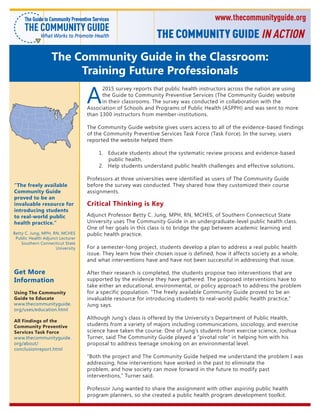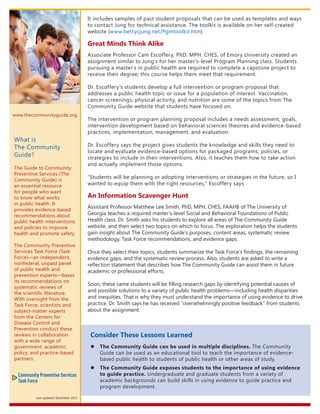Classroom CGiA_final
- 1. The Community Guide in the Classroom: Training Future Professionals A 2015 survey reports that public health instructors across the nation are using the Guide to Community Preventive Services (The Community Guide) website in their classrooms. The survey was conducted in collaboration with the Association of Schools and Programs of Public Health (ASPPH) and was sent to more than 1300 instructors from member-institutions. The Community Guide website gives users access to all of the evidence-based findings of the Community Preventive Services Task Force (Task Force). In the survey, users reported the website helped them 1. Educate students about the systematic review process and evidence-based public health. 2. Help students understand public health challenges and effective solutions. Professors at three universities were identified as users of The Community Guide before the survey was conducted. They shared how they customized their course assignments. Critical Thinking is Key Adjunct Professor Betty C. Jung, MPH, RN, MCHES, of Southern Connecticut State University uses The Community Guide in an undergraduate-level public health class. One of her goals in this class is to bridge the gap between academic learning and public health practice. For a semester-long project, students develop a plan to address a real public health issue. They learn how their chosen issue is defined, how it affects society as a whole, and what interventions have and have not been successful in addressing that issue. After their research is completed, the students propose two interventions that are supported by the evidence they have gathered. The proposed interventions have to take either an educational, environmental, or policy approach to address the problem for a specific population. “The freely available Community Guide proved to be an invaluable resource for introducing students to real-world public health practice,” Jung says. Although Jung’s class is offered by the University’s Department of Public Health, students from a variety of majors including communications, sociology, and exercise science have taken the course. One of Jung’s students from exercise science, Joshua Turner, said The Community Guide played a “pivotal role” in helping him with his proposal to address teenage smoking on an environmental level. “Both the project and The Community Guide helped me understand the problem I was addressing, how interventions have worked in the past to eliminate the problem, and how society can move forward in the future to modify past interventions,” Turner said. Professor Jung wanted to share the assignment with other aspiring public health program planners, so she created a public health program development toolkit. “The freely available Community Guide proved to be an invaluable resource for introducing students to real-world public health practice.” Betty C. Jung, MPH, RN, MCHES Public Health Adjunct Lecturer Southern Connecticut State University Get More Information Using The Community Guide to Educate www.thecommunityguide. org/uses/education.html All Findings of the Community Preventive Services Task Force www.thecommunityguide. org/about/ conclusionreport.html
- 2. Consider These Lessons Learned � The Community Guide can be used in multiple disciplines. The Community Guide can be used as an educational tool to teach the importance of evidence- based public health to students of public health or other areas of study. � The Community Guide exposes students to the importance of using evidence to guide practice. Undergraduate and graduate students from a variety of academic backgrounds can build skills in using evidence to guide practice and program development. It includes samples of past student proposals that can be used as templates and ways to contact Jung for technical assistance. The toolkit is available on her self-created website (www.bettycjung.net/Pgmtoolkit.htm). Great Minds Think Alike Associate Professor Cam Escoffery, PhD, MPH, CHES, of Emory University created an assignment similar to Jung’s for her master’s-level Program Planning class. Students pursuing a master’s in public health are required to complete a capstone project to receive their degree; this course helps them meet that requirement. Dr. Escoffery’s students develop a full intervention or program proposal that addresses a public health topic or issue for a population of interest. Vaccination, cancer screenings, physical activity, and nutrition are some of the topics from The Community Guide website that students have focused on. The intervention or program planning proposal includes a needs assessment, goals, intervention development based on behavioral sciences theories and evidence-based practices, implementation, management, and evaluation. Dr. Escoffery says the project gives students the knowledge and skills they need to locate and evaluate evidence-based options for packaged programs, policies, or strategies to include in their interventions. Also, it teaches them how to take action and actually implement those options. “Students will be planning or adopting interventions or strategies in the future, so I wanted to equip them with the right resources,” Escoffery says. An Information Scavenger Hunt Assistant Professor Matthew Lee Smith, PhD, MPH, CHES, FAAHB of The University of Georgia teaches a required master’s-level Social and Behavioral Foundations of Public Health class. Dr. Smith asks his students to explore all areas of The Community Guide website, and then select two topics on which to focus. The exploration helps the students gain insight about The Community Guide’s purposes, content areas, systematic review methodology, Task Force recommendations, and evidence gaps. Once they select their topics, students summarize the Task Force’s findings, the remaining evidence gaps, and the systematic review process. Also, students are asked to write a reflection statement that describes how The Community Guide can assist them in future academic or professional efforts. Soon, these same students will be filling research gaps by identifying potential causes of and possible solutions to a variety of public health problems—including health disparities and inequities. That is why they must understand the importance of using evidence to drive practice. Dr. Smith says he has received “overwhelmingly positive feedback” from students about the assignment. www.thecommunityguide.org What is The Community Guide? The Guide to Community Preventive Services (The Community Guide) is an essential resource for people who want to know what works in public health. It provides evidence-based recommendations about public health interventions and policies to improve health and promote safety. The Community Preventive Services Task Force (Task Force)—an independent, nonfederal, unpaid panel of public health and prevention experts—bases its recommendations on systematic reviews of the scientific literature. With oversight from the Task Force, scientists and subject-matter experts from the Centers for Disease Control and Prevention conduct these reviews in collaboration with a wide range of government, academic, policy, and practice-based partners. Last updated: December 2015

